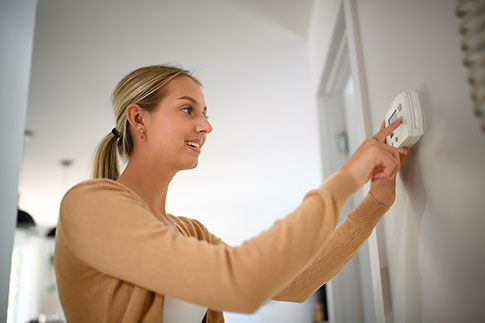Which heating system should you choose?

Need to replace your current system? Trying to decide what kind of heating to install in the new house being built for you? Learn about the pros and cons of the various heating systems, appliances, and energy sources available to you.
Baseboard heating
Electric baseboard heaters are very common in Quebec. They work by natural convection. Air warms up in contact with the baseboard. It then rises because it is lighter than the ambient air, which is colder. This causes air to flow through the room.
Pros:
- Inexpensive to purchase and install.
- Simple to use.
- Appreciated by insurers (lower fire risk and less costly to repair or replace after a claim).
Cons:
- Takes up valuable wall space.
- Doesn’t provide even heat.
- Makes cracking noises when warming and cooling.
- Can cause burns if touched.
Convection heaters
Like baseboards, convection heaters also work by natural convection. However, these electric units distribute heat more effectively. The heater enclosures, which sit higher on the wall than baseboards, produce a powerful chimney effect that pushes hot air out of the unit’s upper slots.
Pros:
- Heat the room faster and more evenly than baseboard units.
- Can be installed anywhere, on exterior walls and interior partitions alike.
- Available in various shapes and sizes to make it easier to find a place for them.
- Quieter than baseboards.
- Come with features like automatic overheat protection and lockable thermostat for greater safety.
Cons:
- Cost 3 to 5 times more than electric baseboards.
- Don’t distribute heat as evenly as a radiant system (e.g., radiant floor).
Unit heaters
Also known as fan heaters or air heaters, these appliances are designed for locations exposed to the cold, such as garages. They may also be suitable for locations too small for a convection heater: under cabinets, in bathrooms, etc.
They work by powered convection: hot air is forced out by a mechanical fan (blower).
Garage unit heaters typically range in power from 2,000 to 10,000 watts. They must be installed in the centre of the ceiling, blowing air downward on all sides so that heat recirculates throughout the room.
Pros:
- Equipped with a built-in thermostat and timer.
- Can heat a room on low speed or, temporarily, on high.
Cons:
- Some models are very noisy.
Radiant heating systems
Radiant heating systems work by radiation. Heat from a warm surface is transferred to a cold surface with no contact between the two. Heat energy is transferred via infrared waves.
In other words, instead of heating the ambient air, the radiant surface or appliance becomes a warm mass that heats other masses around it (walls, furniture, etc.).
Radiant heating systems can be electric or water based. Water-based systems require a boiler, powered by wood, pellets, or natural gas, to heat the water that flows through the pipes.
Radiant floors are the best-known type of radiant heating. Radiant ceilings are also available. Radiators like the cast-iron ones in older homes also operate on this principle. Contemporary versions are available. They look like baseboards or wall convectors and run on electricity.
Pros:
- Gentle, even, enveloping heat.
- Don’t raise dust because they don’t move air.
- Radiant heating systems can be set to a lower temperature than convection heaters without compromising comfort.
- Suitable for ventilated areas such as vestibules. When a door opens and a cold stream of air enters, heat is stored in the thermal mass of the walls and floors.
Cons:
- Generally more expensive than convection heaters.
- Do not produce rapid heat; warm the space gradually.
- Not recommended for installation under certain types of flooring such as hardwood.
- Radiant ceiling or floor systems may limit renovation opportunities.
Central or wall heat pumps
Heat pumps are forced air systems. Most are electric.
They do not produce heat. Instead, they remove heat from the outside air (yes, even when it’s cold!) and transfer it inside the home. They can do the same with cold air, so they can cool a house in the summer.
A central heat pump distributes air throughout the whole house via ducts and vents.
A wall-mounted heat pump, on the other hand, only heats or conditions the air in the room or space it is installed in. It costs less than a central system.
Pros:
- Consume less energy than many other heating systems.
- Heat and cool.
- Keep temperatures balanced throughout the house (central heat pump).
Cons:
- Pull heat from outside air down to a certain temperature (-15°C to -30°C depending on the model). Another system must take over when it is too cold.
- Require de-icing in cold weather.
- Wall-mounted heat pumps heat or cool a single room or space only.
- Central heat pumps require ducts and vents to be installed throughout the house.
- Central heat pumps also require an outdoor unit that takes up space and can be unsightly and a bit noisy.
Central forced air heating systems
The heart of any central forced air heating system is the furnace. It heats air, which is then distributed throughout the house via heating ducts.
Forced air heating systems can be powered by electricity, wood, pellets, or natural gas. Natural gas furnaces are considered less environmentally friendly, as they use non-renewable fossil fuel.
Pros:
- Outstanding energy performance.
- Consistent, even heat throughout the home.
- Highly durable.
Cons:
- Utility room required to accommodate the furnace.
- Ducts and vents must be installed throughout the house.
Energy sources
You have a variety of energy sources to choose from to heat your home. But they’re not all equal when it comes to environmental impact.
Electricity
The most common energy source in Quebec is electricity. Quebec’s electricity comes from renewable sources and emits fewer greenhouse gases (GHGs) than fossil fuels. And electric heating systems don’t emit any GHGs at all.
If you’re worried about power outages, you might want to consider a dual-energy system with a secondary energy source such as wood or gas that can take over as needed. You could also install a wood stove or fireplace as a backup heat source.
Wood
Wood is a renewable energy source. It is an environmentally friendly fuel if used effectively. However, wood smoke releases about 100 contaminants into the atmosphere. That’s why it’s important to opt for a system designed to reduce particulate emissions to a minimum, both indoors and out.
There are other ways to help reduce pollution too, like choosing your firewood wisely.
Pellets
Pellets are made from sawdust. They contain less moisture than conventional firewood. This is important because when wood burns, moisture produces pollutants. As a result, pellet stoves emit fewer pollutants than conventional wood-burning appliances.
Another environmental benefit is that pellets are made from industrial wood waste that would otherwise go to landfill.
Natural gas and propane
Natural gas and propane produce far less carbon monoxide and particulate emissions than wood. But as fossil fuels, they are a non-renewable source of energy. The extraction, refining, transportation, and burning of fossil fuels impacts the environment by releasing greenhouse gases into the atmosphere.

What criteria should you use to choose your heating system?
There are lots of options available for heating your home, both in terms of energy and the appliances themselves. We look at the most common ones here, but there are others, including geothermal systems and masonry heaters. Making a choice isn’t easy, but there are a number of criteria to guide you.
- First, check which energy sources are available in your area. Then check energy prices.
- For an existing home, you’ll also need to consider the heating system you already have. If you have a forced air system, you already have ductwork. Installing an electric heat pump in this case could be simpler and less expensive than in a home without it.
- Be sure to take all costs into account. There is the cost of the appliances themselves, of course, but also the cost of installation by specialists. Then there are the operating and maintenance costs. Given the long-term savings, it may be worth investing some serious cash to replace an obsolete system. But if you don’t plan to keep your home for very long, you may not have time to recoup your investment.
- Find out about government funding and programs. A number of programs exist to help you transition to a greener system.
If you change your heating system, you’re probably hoping for improved energy efficiency and maybe even some savings on heating costs. But your home, its insulation, and your needs and lifestyle also have a big impact. You could reduce your heating bills by following these tips for optimal winter comfort or by using home automation and other technologies. More food for thought!
Given the many options available, it’s a good idea to talk to specialists who can help you make an informed decision. If you are a CAA-Quebec member, call our Residential Advisory Services. Our team of professionals can answer your questions and help guide you. They can also recommend trusted businesses for all your installation and system maintenance needs.
Does the type of heating system you have affect your insurance premium?
Your insurer takes your heating system into account when calculating your home insurance premium. Heating with wood, natural gas, or propane increases the risk of fire. You could end up paying a little more for your insurance as a result.
If you change to an electric heating system, however, your premium could go down.
Regardless of what you decide, it’s essential to notify your insurer of any changes you make. If you don’t, they could refuse to compensate you in the event of a problem.

What about oil-fired heating systems?
In its Regulation respecting oil-fire heating appliances, the Government of Quebec is phasing out the use of fuel oil for heating residential buildings. The goal is to limit the emission of greenhouse gases and other air pollutants.
Installation of oil-fired heating systems in new homes has been banned since December 31, 2021 and since December 31, 2023 for existing homes. Since then, it is impossible to replace existing oil-fired systems with appliances running on fossil fuels, including natural gas and propane. Systems using electricity or other forms of renewable energy will take their place.
It is also impossible to repair oil-fired appliances over 20 years old and oil-fired water heaters over 10 years old.
There is exceptions for homes connected to an off-grid system, like in the Magdalen Islands and some remote communities. Auxiliary oil heating is not covered by the regulation.
You may be eligible for financial assistance to replace your oil-fired furnace or boiler. Check out the Chauffez vert program. Think about your home insurance too: you could save on your premium with this change!

Benefit from personalized advice
Do you have questions about your home, need specific information, or are you looking for referrals to find an Approved Supplier?